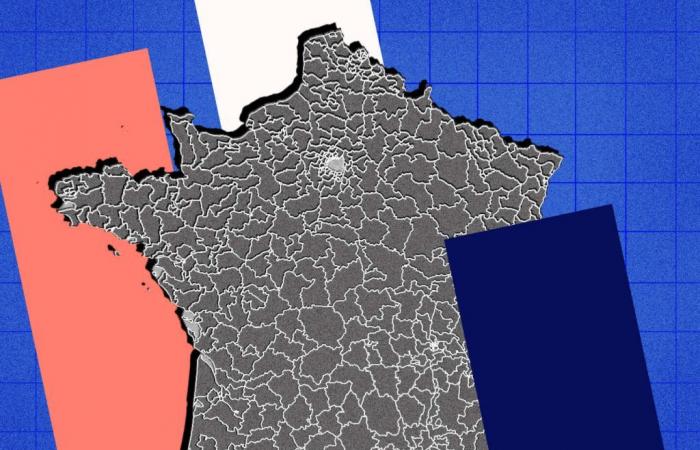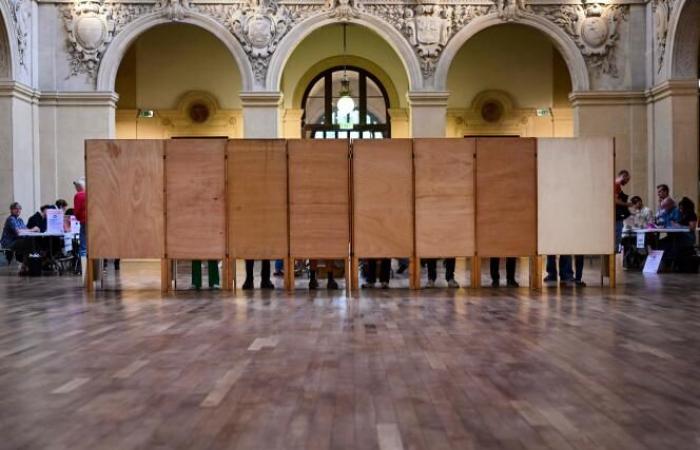Only three weeks after the dissolution of the National Assembly decided by the President of the Republic following the debacle of his party in the European elections, the French are once again called to the polls, Sunday June 30.
Read also | Live, 2024 legislative elections: participation reaches 59.39% at 5 p.m., up 20 points compared to 2022
Add to your selections
While the estimates of the balance of power between the major political parties, expressed as percentages, are generally close to reality, the projections in terms of the number of potential seats for each party are much less so on the evening of the first round, as the outcome of the second round depends on the specific situations in each of the 577 constituencies.
Estimates, seat projections and final results: Les Décoders du Monde take stock of the various figures circulating on election day.
Read also | Discover the list of candidates for the 2024 legislative elections in your constituency
Add to your selections
Voting estimates revealed at 8 p.m.
At exactly 8 p.m., the last polling stations in major cities close their doors, lifting the ban on broadcasting results. Most media outlets then want to give their readers the result of the vote, with the national percentages obtained by each party or coalition. To do this, polling institutes make estimates based on the results of a defined number of stations that they consider representative of the French vote.
Like the French Institute of Public Opinion (IFOP) or Harris Interactive, Ipsos – which produces the Ipsos-Talan estimate for various media – uses this method. The institute sends its investigators to nearly 600 offices constituting their sample. Each of them attends the counting and transmits:
- when the office closes, information on the number of voters, to estimate abstention;
- after the first two hundred ballots counted, a partial result with the scores obtained for each candidate;
- at the end of the counting of the polling station, all the results.
The institute centralizes all this feedback and calculates the estimate of the final result based on a statistical model taking into account geographical particularities (rural municipalities, small or large towns, etc.) and political characteristics (offices traditionally on the left or right, reversal or consolidation of trends observed in the previous election, etc.)
This is not a simple count: in the case of Ipsos, around 70% of the offices in the sample close at 6 p.m., 5% to 10% at 7 p.m. and the rest, 20% to 25%. at 20 hours. Knowing that it takes about an hour to count all the ballots from an office (less, if abstention is high), the institutes have, at 8 p.m., neither the partial results of the offices which have just closed nor even complete results from those who closed their doors at 7 p.m. Each time counts are added, the algorithms refine the estimates.
Read also | Legislative 2024: what are the programs of the main parties?
Add to your selections
This system has a weakness because it relies on the voting dynamics observed in the polling stations that have already closed, to project them onto those that close at 8 p.m. However, these are not always the same ones. If the results of polling stations closing at 6pm and 7pm turn out to be 10 points higher for a party or candidate than in previous elections, but the dynamics are different in metropolises closing later, the first estimate given at 8pm may be wrong before being refined later. This scenario is rare but occurred in the first round of the 2022 presidential election: estimates of Jean-Luc Mélenchon’s score were around 18% at 8pm before rising during the evening to approach 22% as the results from large cities were taken into account, where he did better.
Specificities linked to an expected increase in participation
The method described above provides a correct estimate of the national balance of power between the different parties and coalitions. But it is only a very imperfect prediction of the composition of the future Assembly, since this will depend on 577 separate elections.
The world
Support an editorial team of 550 journalists
Access all our content unlimited from €7.99/month for 1 year.
Subscribe
In addition, the expected increase in participation risks significantly complicating the situation for pollsters. According to an Ipsos survey of June 27, between 61% and 65% of voters could go to vote, compared to 47.5% in 2022.
Mathematically, the higher the turnout, the more likely it is that three – exceptionally four – candidates will be able to remain in the second round. The two candidates who came in first are qualified, as well as those who obtained a number of votes greater than 12.5% of registered voters. In 2022, due to the low turnout, only 8 three-way races were possible in the 577 elections.
Read also | 2024 legislative elections: practical questions for voting
Add to your selections
“The uncertainty of the seat simulations increases on the evening of the first round with the number of triangulars. For example, with the 2022 results, 60% participation would have led to 120 triangulars, and up to 200 with 65% participation.explains Jean-François Doridot, Managing Director of Ipsos Public Affairs.
Polling institutes must integrate these parameters into their sample of polling stations. “When we prepare a first round, we are already preparing a second roundspecifies Mr. Doridot. As we do not know the results of the first round, we need to have polling stations which will reflect all possible triangular configurations in the second round, to be able to anticipate vote carryovers. »
Read also | Article reserved for our subscribers 2024 legislative elections: high participation announced for a major election
Add to your selections
Projections in “very, very fragile” seats
“Very, very fragile”, “perilous”, “take with great caution”…all the pollsters we interviewed agree on the limits of the seat projections broadcast on the evening of the first round. “It’s as if on the evening of the first round of the presidential election, we were trying to give the score for the second round”, already explained to us, in 2022, Jérôme Fourquet, director of the opinion department at the IFOP. Who recognized that there exists a “very strong media and political pressure for there to be screenings in seats” despite limited reliability.
Unlike national estimates in percentages, which are based on the actual results of hundreds of polling stations, the projection in seats is done on the basis of opinion surveys. Harris Interactive surveys 6,000 to 7,000 people on Election Day to “know the sociology of voting, the motivations of voters et potential electoral behavior in the context of the second round.
“We are asking people about the second round without having the result of the first, we do not yet know the duels or the three-way races in their constituency”comments Jean-Daniel Lévy, Director of Politics and Opinion at Harris Interactive. Respondents are asked about several second-round hypotheses, which allows the institutes to calculate possible vote carryovers. “The fragility of the seat simulation comes from the fact that it is based on information that is measured before the first round”agrees Jean-François Doridot of Ipsos.
To give an idea of the number of seats that each political party could obtain, the pollsters take as a basis the national estimate of the results of the first round and project it into each of the French constituencies. This gives the 577 possible posters of the second round on which they base the results of their opinion polls, to estimate the transfer of votes of the unqualified candidates and outline the possible National Assembly at the end of the second round.
Each party is allocated a range of seats, but the margin of uncertainty remains too great. Varying the trend of a political force by one or two points in the first round can thus swing thirty to forty seats in the projected Hemicycle.
The heads of the institutes interviewed all recognize the limits of these figures which do not take into account the particularities of each constituency, local figures, dissidents and the campaign dynamics between the two rounds.
Despite all these limitations, the three polling institutes published seat projections on the evening of the first round two years ago. Jean-François Doridot specifies that if Ipsos will provide seat projections on the evening of the first round, they will not propose them before, “the weaknesses before the election being too strong.”
On the evening of the second round, these projections should on the contrary be more reliable, without necessarily being exact down to the seat, since the respondents will, this time, have been questioned on known configurations and no longer simply hypothetical.
Official results continue until late at night
The Ministry of the Interior, responsible for organizing the elections, begins to publish the results by municipality from 8 p.m., then updates its publications continuously. In the early evening, only the results of the smallest municipalities, quickly counted, are available.
After the closure and counting of nearly 70,000 polling stations, the results are sent to the prefectures, which in turn send them to the Ministry of the Interior. They are then published as they are received. The results for all constituencies are usually not known until late on Sunday night.
The results are considered final once validated by the Constitutional Council, after examination of potential cases of irregularities.
A previous version of this article was published in June 2022, on the occasion of the last legislative elections.







